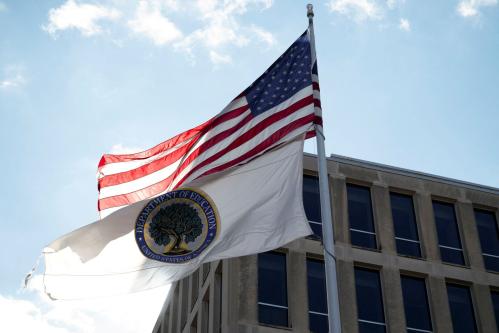In this edition of Charts of the Week: the relationship between age and happiness; the racial wealth gap concentrates Black Americans among the poor; and the case to get rid of the Electoral College.
LIFE SATISFACTION DECLINES AFTER RETIREMENT

David Blanchflower and Carol Graham observe the relationship between happiness and aging in the U.S., which has experienced “particularly stark” trends of declining mental health and well-being, and rising deaths of despair. They find that life satisfaction follows a U-shape from age 18 to retirement, dipping with a mid-life low in the mid-40s. Then, as indicated by the chart, life satisfaction begins to decline in the 70s and after age 80, largely due to widowhood and health shocks. “The direction of causality is not clear, given that poor health or other life shocks lower well-being across the life cycle,” they explain. “Yet the new evidence shows that higher levels of well-being ex ante predict longevity.”
US RACIAL WEALTH GAP LEAVES BLACK HOUSEHOLDS OVERREPRESENTED AMONG THE POOR

In a brief as part of the Brookings Blueprints for American Renewal & Prosperity project, Vanessa Williamson explores how centuries of discrimination against Black Americans has left a racial wealth gap of $10.4 trillion. This disparity is closely tied to wealth concentration in contemporary America, she says, where the 400 richest billionaires have more total wealth than all 10 million Black American households. The chart indicates the overrepresentation of Black households among the poor and working class. Of the poorest 20% of American households, 26% identify as Black; while of the richest 20%, only 3% identify as Black. “Black people in American have been systematically stripped on the wealth they have produced,” she writes. “Only a transformative national agenda can address the racial wealth gap, because the disparity is the product of societal racism, compounded over generations.”
ELECTORAL COLLEGE FAILS TO EQUALLY REPRESENT MORE POPULOUS STATES
Elaine Kamarck and John Hudak argue that the Electoral College must be eliminated because it leaves the most populous states in the country dramatically underrepresented in the electoral system. The chart shows that the disparities between the biggest and the median states by population have increased throughout the 20th century. In 1900, the state with the median population (Louisiana) held 19% of the population of the largest state (New York). However, by 2019, the median state (Kentucky) comprised only 11% of the most populous state (California). “These imbalances effectively ensure that some votes in presidential elections are worth more than others,” they say, “and as that imbalance scales up across the entire Electoral College, it can (under the right circumstances) provide the recipes for popular vote winners losing the Electoral College.” But because amending the U.S. Constitution to do away with the Electoral College, Kamarck and Hudak explore different solutions, including the National Popular Vote Interstate Compact.
The Brookings Institution is committed to quality, independence, and impact.
We are supported by a diverse array of funders. In line with our values and policies, each Brookings publication represents the sole views of its author(s).




Commentary
Charts of the Week: Age and happiness; racial wealth gap; Electoral College reform
December 11, 2020